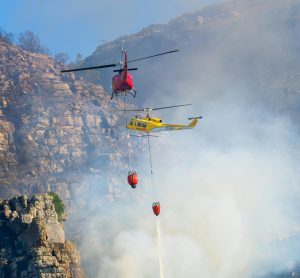Written by Anna Kalagia
Reading time 5 minutes
The Current Environmental Conditions
It is well-known that our human existence and action on our planet has contributed both positively and negatively. In terms of negative impact, our constant need to find resources that sustain our survival leads to environmental abuse. The nature, trying to meet our demands, is undergoing changes that greatly affect human life. In this way, every day we are dealing with news of natural disasters that endanger human societies.
Floods, earthquakes, storms, wildfires are becoming the most common ground between countries all over the planet. In case of natural disasters of this kind, there are no frontiers. All regions, irrespective of their level of development, are affected and hampered by new environmental conditions. However, can the Nations by themselves cope with these difficulties? Is there any global or local structure that focuses on this problem? The answer lies in the activity of the European Union.
The European Union As a Helper
The EU, having adopted the 2030 Agenda, is also committed in implementing the 17 Sustainable Development Goals in all its policies. Among these goals, the 13th deals with climate action. This means that European Union is responsible for fighting against the threat of climate change and its impacts. In particular, in line with target 13.1 European Union has to enhance resilience and capacity to adapt to climate-related risks and natural disasters in all countries.
In the context of the above practice, the European Commission had already established the EU Civil Protection Mechanism in 2001. This kind of mechanism acts like a well-coordinated joint disaster response worldwide. EU countries and 10 participating states are ready to cooperate in responding to emergency by mobilizing specialized teams and equipment. This Mechanism records 700 actions inside the EU and around the world.
In 2019, the European Commission decided to expand the strength of EU Civil Protection Mechanism by creating the RescEU. This establishment aims to the protection of citizens from disasters and its impacts. More specifically, it tries to ensure the European disaster and health preparedness by using firefighting planes and helicopters, medical evacuation planes, medical items and field hospitals. RescEU also deals with chemical, biological, radiological and nuclear (CBRN) risks. The main basis on which this structure is built is the fact that several countries simultaneously face the same type of crisis.
Being financed by EU, RescEU is considered as a great citizen protection because it can respond to all kind of emergencies connected to extreme weather conditions or emerging threats. When a country stands unable to deal with the disaster on its own, then it can use the EU Civil Protection Mechanism and therefore the RescEU in order to protect its people. In this way, European Union is considered as an important ally in the sustainability of countries and their security. Countless examples confirm this view inside and outside European Union.

Picture by Jean van der Meulen – Pexels.com
The European Civil Protection Pool And Its Assets
With a view to be prepared for any occasion anytime, European Union created the European Civil Protection Pool. All member-states and other participating states offer their capacities to realize the aim of the RescEU in the framework of the European Civil Protection Mechanism. The assets which consist that “pool” are firefighting teams, aircraft, flood containment, water purification, medical supplies and CBRN detection and sampling. Europe support RescEU capacities by co-financing them at 75% of operational costs for use inside EU and 75% of transport costs for deployment outside EU. In this way, member-states are covered to offer help irrespective of their financial capacity.
The Example of Greece
One of the most notable cases of ResEU’s assistance in European Union is Greece. On 13 August 2019, while Greece was suffering from devastating wildfires, ResEU took action. Using firefighting planes from his fleet based on Italy and Spain, ResEU focused on saving the Greek forests. This is considered as the first active effort by RescEU to provide proper assistance. Both Italy and Spain responded to the call by providing their available firefighting equipment.
This simple example helps us to understand the importance of the RescEU. In cases when a member is not capable of dealing with an emergency, then it can request assistance via the Mechanism. In this way, all the member states who participate in the Mechanism offer their available assets in order to help the state in need. All EU member-states support RescEU and try to be available on demand. Other than member-states, Iceland, Norway, Serbia, North Macedonia, Montenegro and Turkiye declare themselves present at this project of the European Union.
The Devastating Earthquakes In Türkiye And Syria
In 2023, our world experienced another one example of the effects of extreme natural disasters. Both Türkiye and Syria had to rebuilt after the impacts of the earthquakes. European Union, wishing to contribute to reconstruction efforts, activated the EU Civil Protection Mechanism. In this way, the Union managed to offer rescue teams, shelter items, emergency supplies and funds. The assistance was immediate including the majority of member-states as well as other countries like Dubai.
More specifically, the Swedish Civil Contingencies Agency who handles one of the RescEU’s emergency stocks of medical equipment and other assets such as helicopters and scooping aircrafts, offered great amount of emergency housing, beds, heaters and other equipment via RescEU. 500 Relief Housing Units , 2000 tents and 8000 beds were delivered to Türkiye in order to accommodate homeless people. Actions like this one underline that the European Union is ready to take action to help the countries of the European Continent in times of need.
One More Step Forward
After a brief analysis of the role of the RescEU, it is understood that such efforts promote the protection and the sustainability of European citizens. By participating in this kind of mechanism, member-states strengthen their preparedness against natural disasters and, in addition, support the unity of European Union. The examples cited are just a few of those which can prove the necessity of the RescEU in the field of sustainable and secured Europe.
European Union with respect for present and future generations, acts in a way which can predict future risks and protect both nature and citizens. However, climate change, among other threats, is going to be a major risk factor for our planet and there is a great need of being prepared to deal with its impacts.
 “My name is Anna Kalagia and I’m 25 years old. My studies in the Panteion University of Social and Political Sciences based in Athens brought me into contact with the term of sustainable development. I would therefore like to focus on issues relating to sustainability and the role of the European Union in this endeavour. A sustainable future is a right of all generations and therefore everyone, and especially the younger generation, must be informed and take action. In addition, my experience in writing will help me to create articles that will serve as a channel of communication between sustainability policies and stakeholders, creating a fertile environment for discussion and action. Hence, I’m joining Circle of Sustainable Europe (CoSE) to express my ideas.”
“My name is Anna Kalagia and I’m 25 years old. My studies in the Panteion University of Social and Political Sciences based in Athens brought me into contact with the term of sustainable development. I would therefore like to focus on issues relating to sustainability and the role of the European Union in this endeavour. A sustainable future is a right of all generations and therefore everyone, and especially the younger generation, must be informed and take action. In addition, my experience in writing will help me to create articles that will serve as a channel of communication between sustainability policies and stakeholders, creating a fertile environment for discussion and action. Hence, I’m joining Circle of Sustainable Europe (CoSE) to express my ideas.”
BIBLIOGRAPHY
https://civil-protection-humanitarian-aid.ec.europa.eu/what/civil-protection/resceu_en
https://ec.europa.eu/commission/presscorner/detail/en/ip_19_5289
https://ec.europa.eu/commission/presscorner/detail/en/QANDA_19_2590
IMAGES
https://ec.europa.eu/commission/presscorner/detail/en/ip_19_5289

